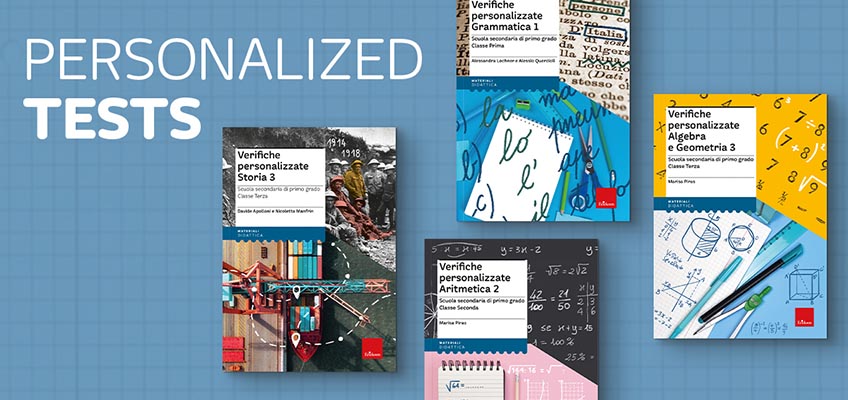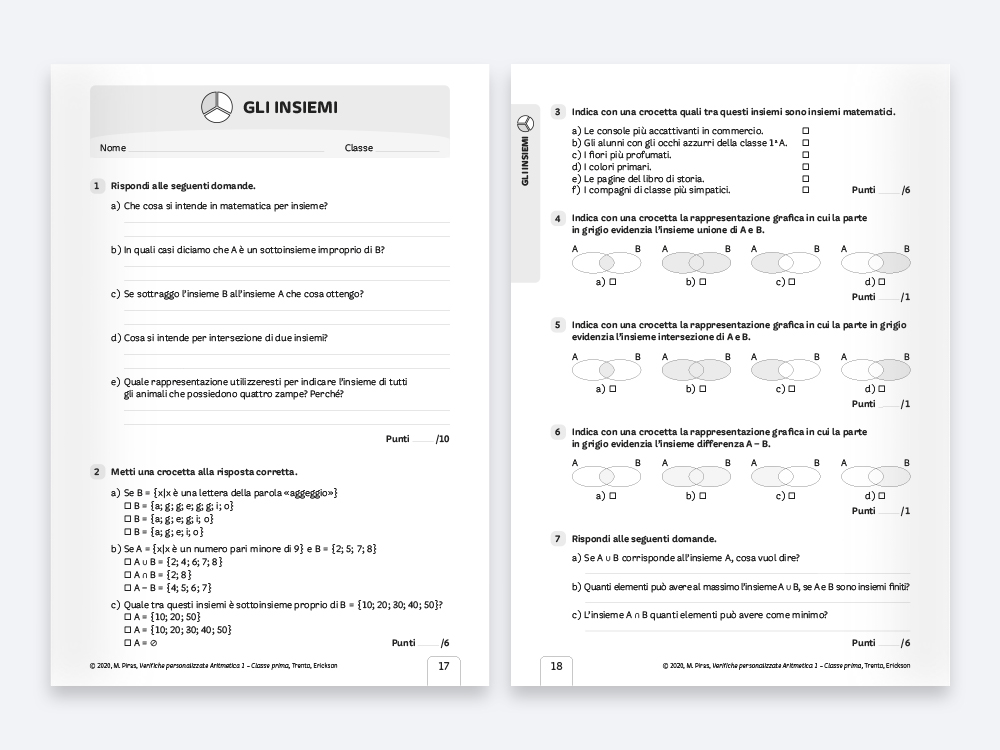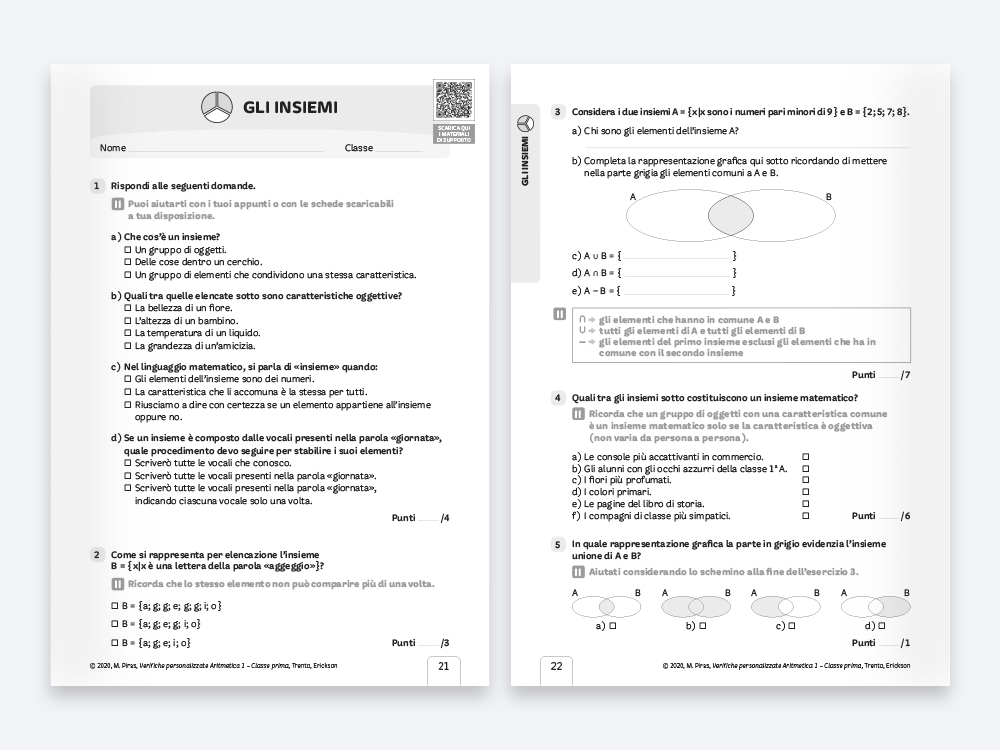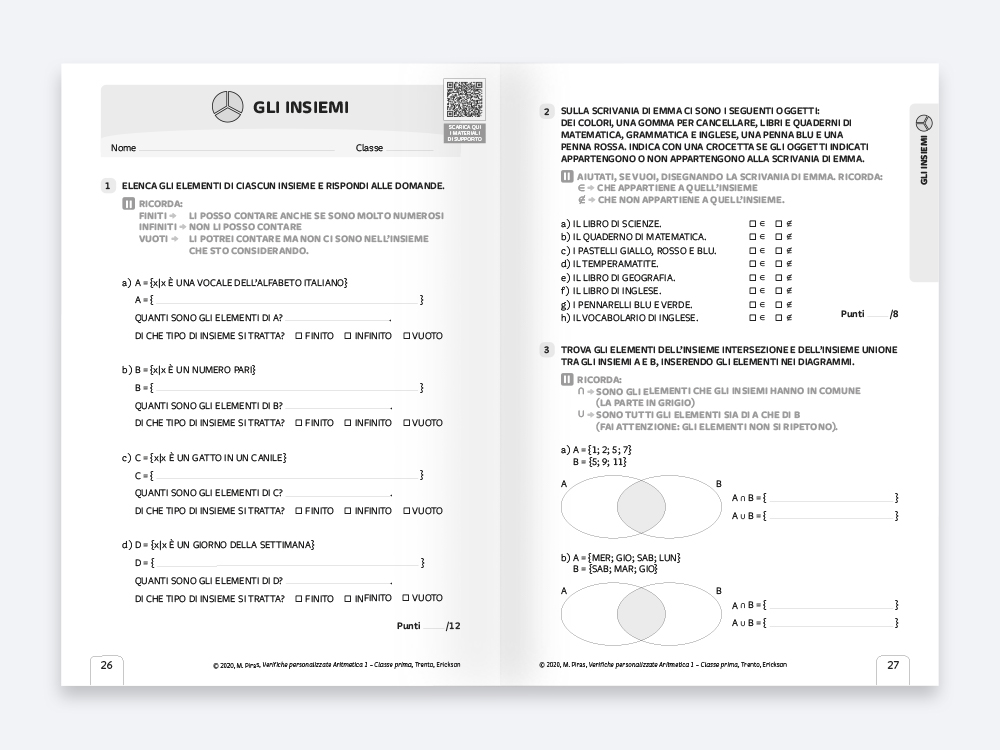 EN
EN
 PT
PT
Lower secondary school - first year
Product: Book
Trim size in cm: 21x29,7cm
Pages: 192
ISBN: 9788859023722
Publication date: 01/10/2020
Suitable for: Lower secondary 1st level (ages 10-11)
REQUEST A SAMPLE OR MORE INFORMATION
This volume offers lower secondary school teachers specific materials for the evaluation of pupils on the first year mathematics programme, to facilitate the processes of inclusion in the classroom and provide each pupil with a level of verification appropriate to their personal resources.
The volume offers tests in three versions, corresponding to the same number of levels of complexity, to allow students to better demonstrate what they have actually learned.
The 3 levels of simplification:
Standard test
The standard test is suitable for the whole class, calibrated on the key contents for each area in which the pupil is required to demonstrate knowledge and understanding.
Facilitated test
The facilitated test is designed for students with Specific Learning Disorders (SLD) or with a level of difficulty that is only executive. It is aimed at reducing the general impact of the typical difficulties related to SLD students on general tests and offers examples or visual aids that facilitate performance on the test without reducing the overall difficulty of it.
Simplified test
The simplified test is based on a reduction in the complexity of the required task. It is a test aimed at students with a more marked and stable cognitive difficulty or with a particularly complex school history, which affects general performance. It proposes an overall reduction of the task and the simplification of the vocabulary.
Tests are proposed as individual tasks or can be completed in cooperative learning. Each test also includes a metacognitive section for self-assessment, which stimulates the student to reflect on the work done and the level of mastery achieved in the various topics.
Self-evaluation box
The self-assessment and metacognitive reflection box, positioned at the end of all three levels of the tests is a tool for the teacher: it allows a phase of monitoring and growth awareness within the class or with the individual student.
The series Personalized Tests
The series Personalized tests offers teachers a wide and accurate choice of materials for the assessment of students on the main subject contents.
Sets
Numbers and the numbering system
Addition and subtraction
Multiplication and division
The four operations
The language of problems
Powers and their properties
Powers: scientific notation and ranking of size
Powers: calculations, expressions and problems
Divisibility: multiples, divisor, divisibility criteria and factoring
Divisibility: lowest common multiple and greatest common divisor
Fractions: classification and properties
Fractions: operations and problems


The series of Personalized Tests offers lower secondary school teachers a wide and accurate choice of materials for assessing pupils on the main subject contents.
Evaluation is a fundamental part of teaching, specifically formative evaluations, to be used as a monitoring action and not as an exclusive final step in a learning path. The volumes of the series Personalized Tests - Lower Secondary School propose an effective customization with the aim of offering teachers of inclusive, multi-ethnic schools who are attentive to the needs of each individual child, three different levels of verification on the main topics of the disciplines, with specific measures and targeted facilitations for each level. An effective personalized test allows the teacher to calibrate the cognitive effort required of pupils in a more specific way, emphasizing the focus of attention and effort on the content, avoiding that these energies are wasted in trying to understand the task or become diluted due to executive difficulties.
THE THREE LEVELS OF TESTS
Each test present in the book is proposed in three versions corresponding to as many levels of complexity, to allow students to better demonstrate what they have actually learned.
Basic test The basic test is suitable for the whole class, calibrated on the key contents for each topic area in which the pupil is required to demonstrate knowledge and understanding.

Facilitated test The facilitated evaluation is designed for students with Specific Learning Disorders (SLD) or with an executive level of difficulty. It is aimed at reducing the general impact of the typical difficulties related to SLDs on the general tests and proposes examples or visual aids that facilitate the completion of the test without reducing the overall difficulty.

Simplified test The simplified test is based on a reduction in the complexity of the required task. It is a test aimed at students with a more marked and stable cognitive difficulty or those who have a particularly complex school history which affects general performance. It proposes an overall reduction of the task and simplification of the vocabulary.

Each test also includes a metacognitive section for self-assessment, which stimulates the student to reflect on the work done and the level of mastery achieved in the various topics.
Self-evaluation box The self-assessment and metacognitive reflection box, found at the end of all three levels of verification, is a tool for the teacher: it allows a phase of monitoring and growth awareness within the class or with the individual student.
THE BOOKS
GRAMMAR 1 First Year
Topics: Phonology - Orthography - Articles - Nouns - Adjectives - Pronouns - Verbs (1st part) - Verbs (2nd part) - Adverbs - Prepositions - Conjunctions - Interjections
GRAMMAR 2 Second Year
Topics: Simple sentences or propositions - Subject - Predicate - Attribute, affixing and complements - Object complement and predicative complements - Indirect complements, specification, term, agent, efficient cause, place, origin, removal, time, mode, means, cause, advantage, company, relation, subject, matter, quality, age, limitation, etc.
HISTORY 1 First Year
Topics: The arrival of the Germanic peoples and the fall of Rome - The Longobards - Islam and the formation of the Arab-Islamic Empire - Charlemagne and the Holy Roman Empire - Feudalism - The Holy German Roman Empire and new invasions - The rebirth of the year One Thousand - The Maritime Republics and the Crusades - The Comunes and conflict with the Empire - National monarchies - The monastic orders and the Eastern schism - The 14th century crisis - Lordships
ARITHMETICS 1 First Year
Topics: Sets - Numbers and the numbering system - Addition and subtraction - Multiplication and division - The four operations - The language of problems - Powers and their properties - Powers: scientific notation and ranking of size - Powers: calculations, expressions and problems - Divisibility: multiples, divisor, divisibility criteria and factoring - Divisibility: lowest common multiple and greatest common divisor - Fractions: classification and properties - Fractions: operations and problems
ARITHMETICS 2 Second Year
Topics: Entrance test for second year - Generating fractions from decimal numbers - The square root operation and its properties - Approximation and use of numerical tables - Ratios, proportions and the calculation of the unknown terms - Proportions: properties and problems - Percentages and problems with percentages - Representation scales, percentage variations and areograms - Mathematical functions and empirical functions - Direct and inverse proportionality - Simple three problems and distribution problems - Probability - Statistics
ALGEBRA AND GEOMETRY Third Year
Topics: Entry test in arithmetic for third year - Geometry entry test for third year - Relative numbers - Literal and monomial expressions - Polynomials and notable products - Equations - Points and segments on the Cartesian plane - The line : reciprocal equation and position of two straight lines - Length of the circumference and area of the circle - Solids and their characteristics - Polyhedra and rotational solids.